Key takeaways:
- Selective mutism is an anxiety disorder that impacts a child’s ability to speak in certain social settings, often misinterpreted as shyness.
- Raising awareness about selective mutism is essential to combat misconceptions and support affected children and their families.
- Strategies for overcoming silence include practicing dialogue in safe spaces, gradual exposure to speaking situations, and using visual aids to express thoughts.
- Creating supportive environments and celebrating small victories can significantly enhance communication for individuals with selective mutism.

Understanding Selective Mutism
Selective mutism is a complex anxiety disorder that affects a child’s ability to speak in certain social situations, most often in school or with peers. I remember a time when a friend’s daughter would light up at home but become completely silent at school—her eyes told a story of fear and confusion. Can you imagine the frustration and isolation that comes with wanting to speak but feeling unable to do so?
For many children, this condition is not simply shyness; it stems from deep-seated anxiety. I often wonder how daunting it must be to face a classroom filled with unfamiliar faces, knowing that the very words you want to share are trapped inside you. The internal struggle can be overwhelming, leaving children feeling like they don’t belong, which is heartbreaking to witness.
It’s important to understand that selective mutism doesn’t reflect a child’s intelligence or desire to socialize. I once spoke with a parent whose child, despite her silence in public, was a bright conversationalist at home. It made me reflect on how we often misinterpret silence; it’s a protective mechanism rather than an unwillingness to engage. How can we help these kids find their voices in environments where they feel safe to express themselves?
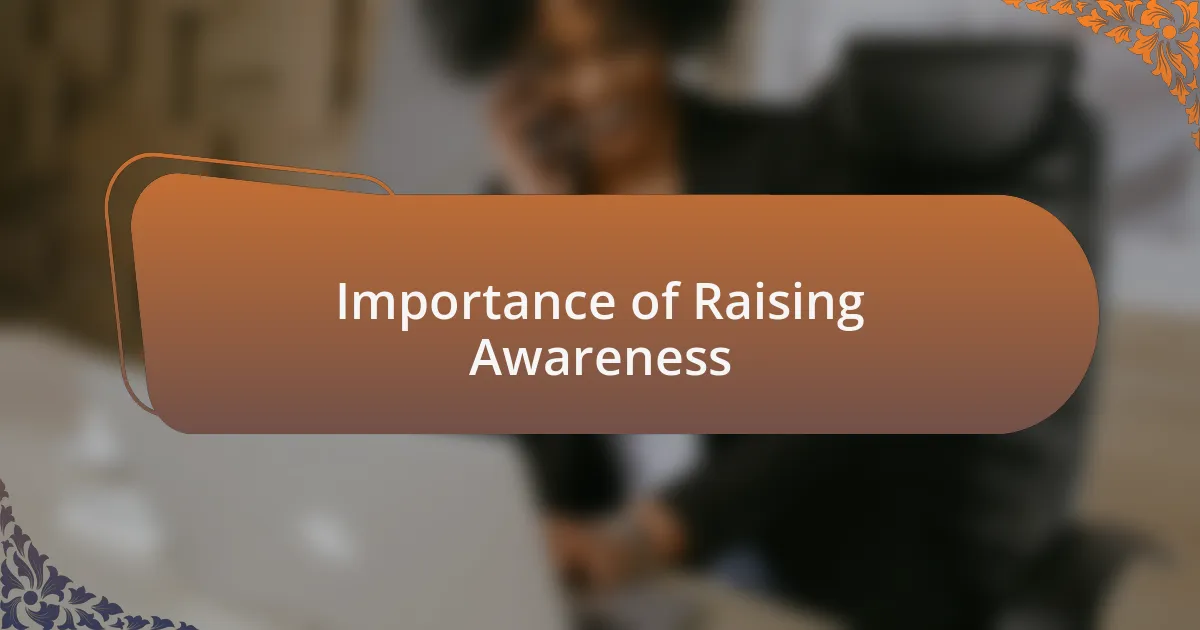
Importance of Raising Awareness
Raising awareness about selective mutism is vital because it fosters understanding and empathy. I recall attending a school event where a teacher shared stories about her students with selective mutism. Seeing the audience’s eyebrows raise in surprise during those moments highlighted how little most people know about the challenges these kids face. Have you ever considered how empowering it is to shed light on these often-overlooked experiences?
When we talk about selective mutism, we challenge the stigma that silence equates to a lack of willingness to communicate. I once overheard a casual conversation in a coffee shop where someone dismissed a quiet child as simply “shy.” Hearing that made me realize that without awareness, misconceptions can easily thrive. Wouldn’t you agree that fostering a supportive environment requires us to educate others on what these children truly experience?
Furthermore, raising awareness not only benefits children, but also their families who often feel isolated in their struggle. I remember chatting with a mother who felt alone in her journey—she wished for resources and support but found that few understood her child’s condition. Imagine how much more connected she would feel if there was a broader conversation about selective mutism, providing a community of support for families navigating these waters together.
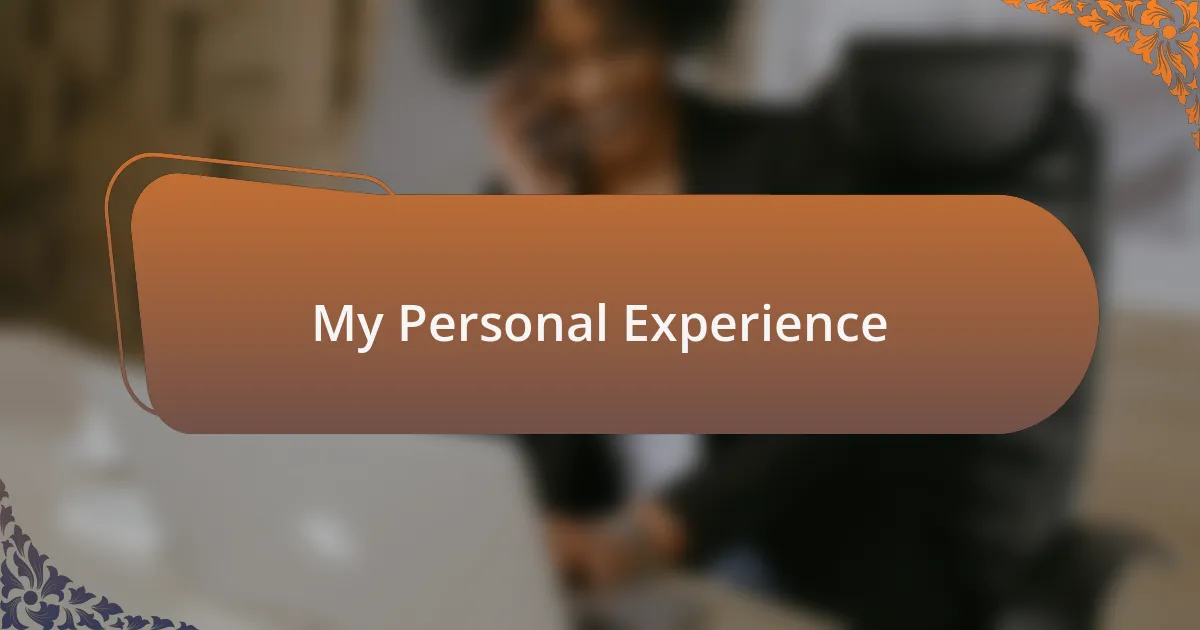
My Personal Experience
My journey with speaking up has been a complex one. I remember when I was young, feeling a surge of anxiety wash over me whenever I had to voice my thoughts in a classroom. The moment all eyes turned my way, I felt like the walls were closing in, and my words would vanish before they had a chance to escape my lips. Have you ever felt that way? It’s as if the mouth becomes a locked vault.
I also recall a pivotal moment during a group presentation in high school. After weeks of preparation, I stood in front of my classmates, heart racing, and somehow managed to share my part. The applause at the end felt like a small victory, reminding me of the power of speaking up. It made me wonder, what might we achieve if we consistently pushed through our fears?
There were times, though, when I hesitated to speak, worried about the reactions of others. I vividly remember a time at a family gathering; I chose silence thinking it would be easier. In hindsight, I wished I had voiced my ideas, realizing that speaking up can bridge gaps and create connections. Isn’t it interesting how finding our voices can lead to greater understanding, not just for ourselves but for everyone around us?
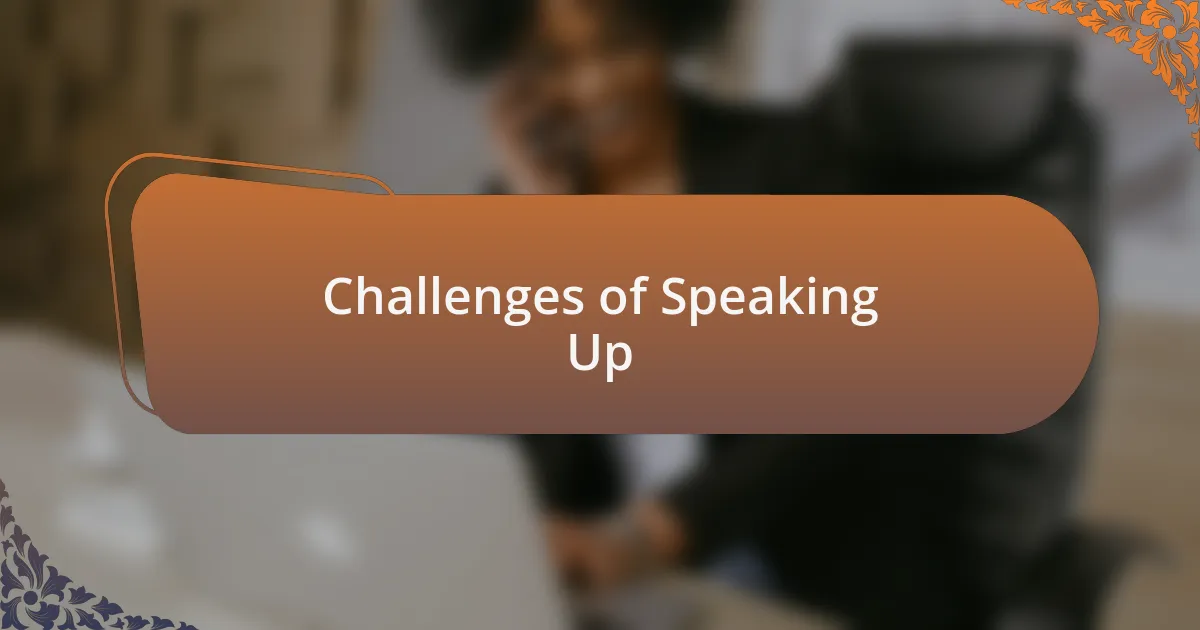
Challenges of Speaking Up
Speaking up often feels like standing at the edge of a cliff, heart pounding as I decide whether to leap into the unknown. I recall a time at work when I had a brilliant idea I knew could improve a process, yet I hesitated during the meeting. The fear of being dismissed or misunderstood loomed larger than the excitement of sharing my thoughts, and that silence weighed heavily on my shoulders.
Another challenge I faced was the impact of past experiences. For instance, I once offered a suggestion during a family discussion, only to be met with silence and a quick subject change. That moment stung. Ever since then, I’ve grappled with the belief that my voice doesn’t matter, which often keeps me from speaking up even when I know I have something valuable to contribute. Have you ever experienced this kind of discouragement?
I often find myself wrestling with the double-edged sword of vulnerability and authenticity. It’s empowering to share my thoughts, yet the fear of being judged or misunderstood can be paralyzing. Just think about it: Why do we often place so much value on the potential reactions of others? I believe the journey to overcoming these challenges lies in embracing our vulnerability and realizing that our voices are worthy of being heard.
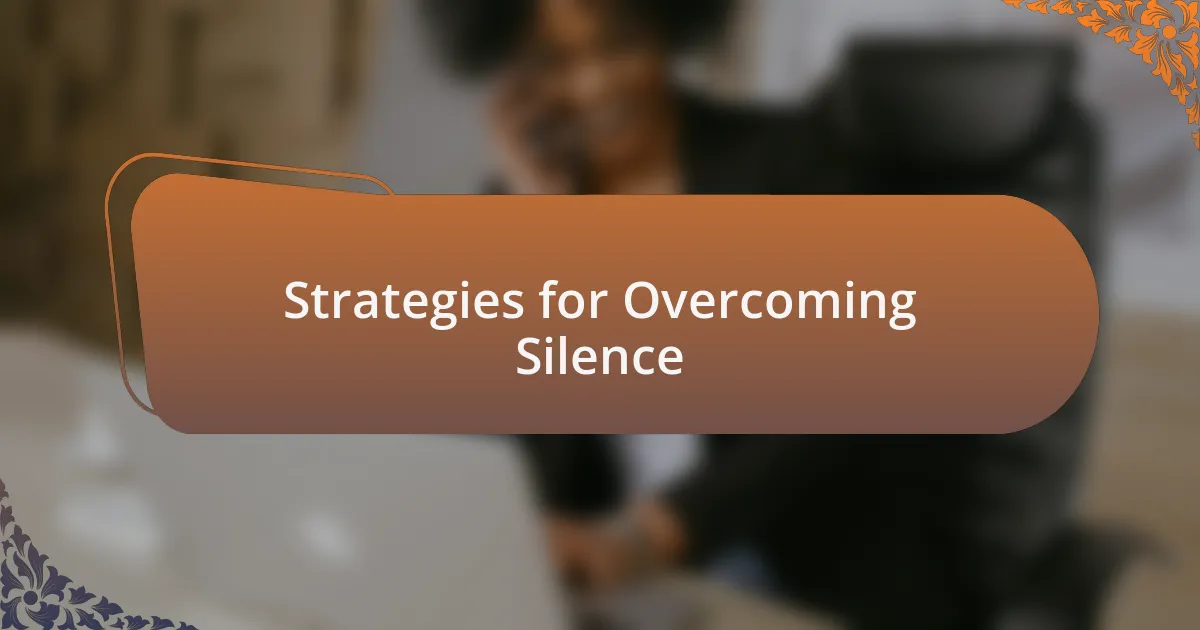
Strategies for Overcoming Silence
One effective strategy for overcoming silence is practicing small dialogues in safe spaces. I remember sitting in a cozy café with a close friend, where I shared brief thoughts on a book we’d both read. That small act of speaking, in a comfortable environment, gradually built my confidence. Have you ever tried sharing your opinion in a low-pressure setting? It’s incredible how such interactions can boost our self-esteem, making it easier to express ourselves in larger groups.
Gradually exposing myself to speaking situations has also been quite transformative. I recall joining a local book club; initially, I barely uttered a word. However, as time passed, I found myself chiming in more frequently. What shifted for me was the realization that everyone in that room had a shared interest, making it less threatening to contribute my voice. This experience taught me that finding common ground with others can significantly reduce the fear of speaking up.
Another approach I’ve found helpful is using visual aids or prompts to express my thoughts. During a recent team meeting, I brought a simple chart illustrating my idea. Holding something tangible gave me the courage to speak out, as I felt like I had a safety net. Have you ever considered using tools like these to communicate? It can be surprising how such aids can alleviate the pressure of articulating thoughts in an intimidating environment.
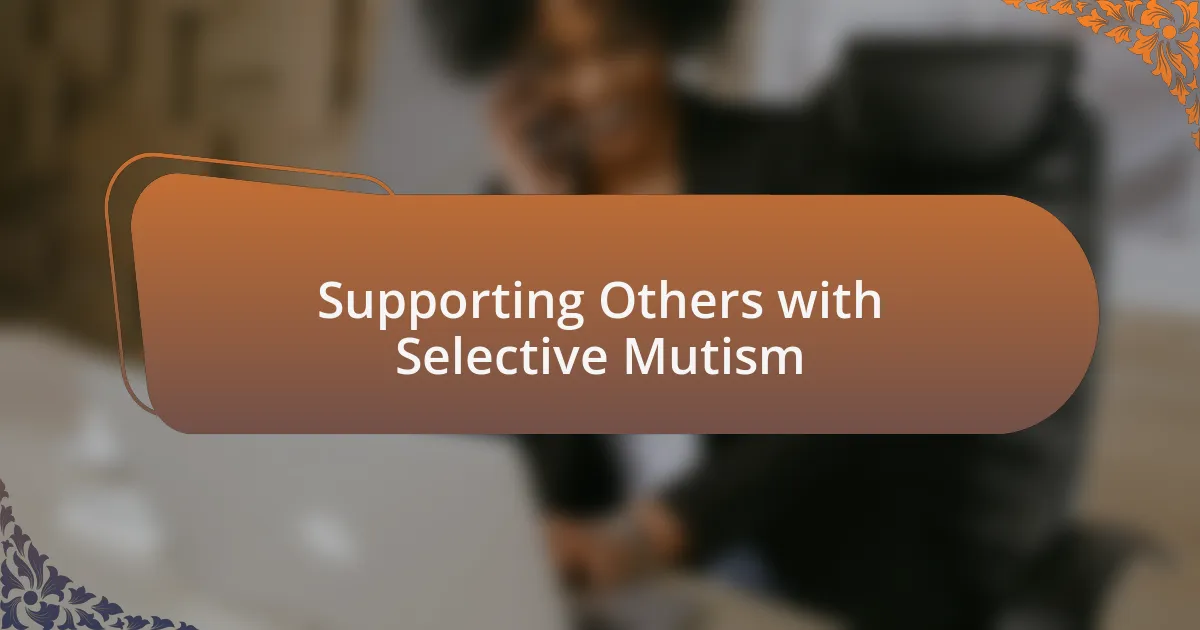
Supporting Others with Selective Mutism
Supporting someone with selective mutism requires patience and understanding. I remember a time when a close family member struggled to voice her thoughts during family gatherings. Instead of pressuring her to speak, I made a point to create a welcoming atmosphere by engaging her through written notes. This simple approach not only allowed her to express herself but also showed her that her voice mattered, even if it wasn’t heard out loud.
Another important aspect is validating their feelings without pushing them beyond their comfort zone. There was a moment when a friend of mine felt overwhelmed and shut down during a discussion. Rather than jumping in to fill the silence, I chose to sit with that silence and reassure her that it was okay to take her time. Have you ever felt that supportive presence with someone? It’s amazing how creating a space for them to breathe and gather their thoughts can lead to breakthroughs in communication.
Lastly, I’ve found that being a role model in communication can have a profound effect. I often share my own struggles with speaking up and how I’ve coped, which helps others feel less isolated. When we openly discuss our challenges, it not only fosters connection but also encourages those with selective mutism to take their own steps towards expressing themselves. Do you think sharing personal experiences can empower others? I truly believe it fosters a sense of community and understanding.
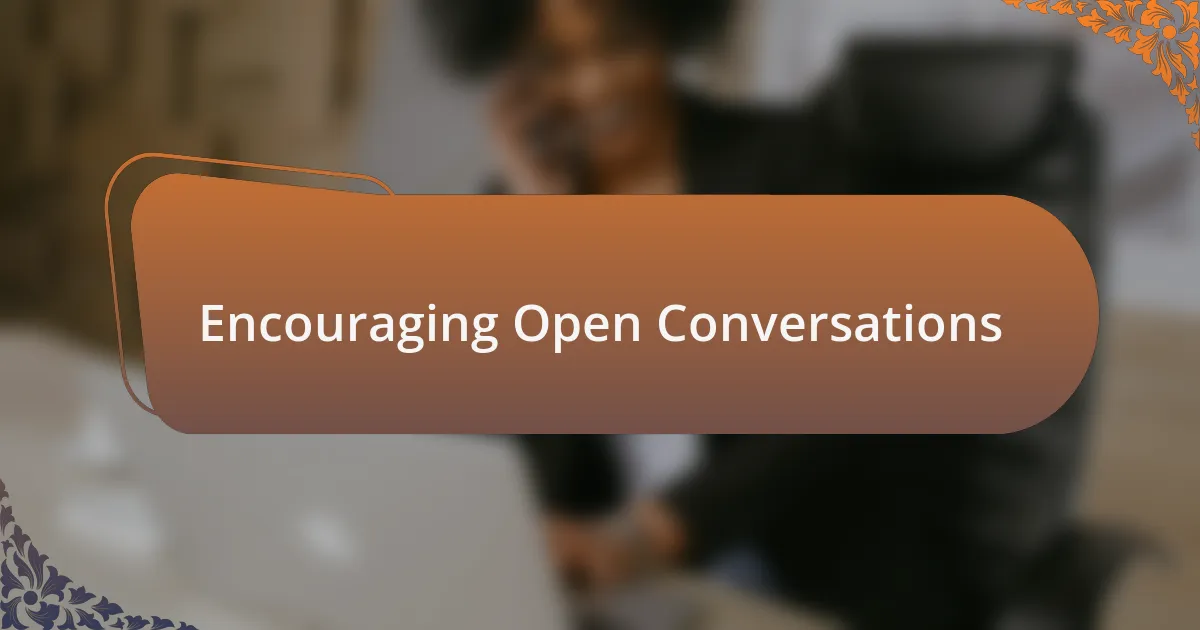
Encouraging Open Conversations
Creating a safe environment for open conversations can make all the difference for someone with selective mutism. I recall a time when I attended a workshop focused on communication barriers. The facilitator encouraged us to write down our thoughts on shared cards, which were later read aloud anonymously. This not only helped me feel more comfortable sharing my own feelings but also demonstrated how others experienced similar struggles. Does that approach resonate with you?
Another strategy I found effective is incorporating playful activities that encourage dialogue without the pressure to speak. During a game night, I introduced a storytelling game where participants could only add a sentence if they felt inspired. This relaxed atmosphere sparked laughter and creativity, allowing quieter individuals to contribute in their own way. Have you noticed how playful settings can unlock hidden voices? It’s remarkable how laughter and fun can lower barriers to communication.
It’s also essential to acknowledge the small victories in these conversations. I remember celebrating when a friend who rarely spoke in group settings managed to share a thought during a casual chat over coffee. Encouraging such moments not only builds their confidence but also reinforces that their contributions are valued. Are you aware of how these little triumphs can create a ripple effect in someone’s willingness to engage? I believe that recognizing and applauding these achievements is key in nurturing open dialogue.